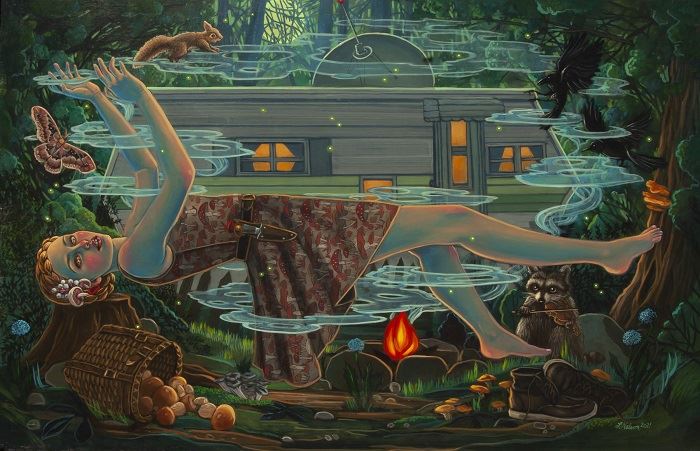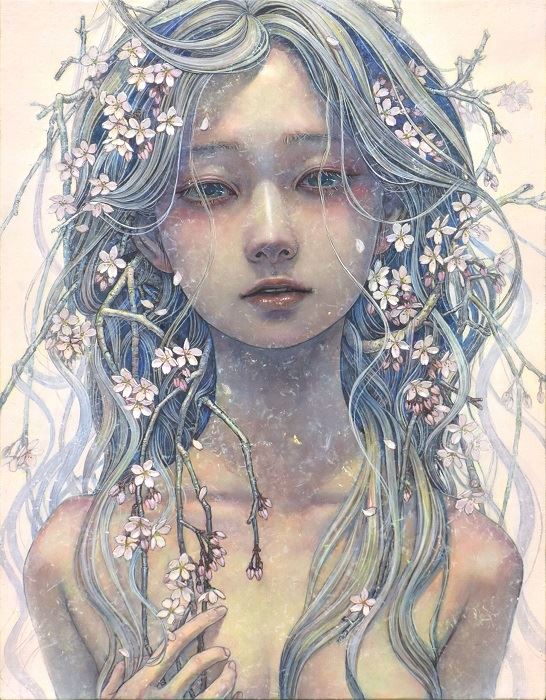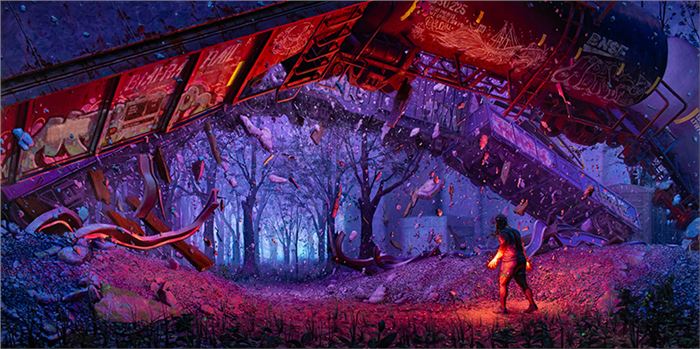Source: Mutual Art.
The Zoomer generation shares a new sense of the aesthetic, one that will undoubtedly influence the future of art. Here’s how they are different.
Generational change matters. A century ago, the great quantum physicist Max Planck observed that, “A new scientific truth does not triumph by convincing its opponents and making them see the light, but rather because its opponents eventually die, and a new generation grows up that is familiar with it.” So it goes with art. Now, as the pioneers of Generation Z (Zoomers) turn twenty-four, their ideas are inevitably becoming important new aesthetic themes. Earlier generations may not understand, or appreciate the new aesthetic, and may reject it as childish, or naïve, or foolish, but it is here, and it dominates the Zoomers’ visual world. There is abundant opportunity here for collectors playing the long game, for presently the Zoomer art market is profoundly undervalued, and masterpieces of their aesthetic are available for the sharp-eyed.
Born after 1996, Generation Z has been raised on computers — they have never known life without shining screens, without easy access to distant friends, without instant information. Their aesthetics have been shaped by their tablets, on their phones, and in their virtual reality headsets, and their understanding of beauty has come through them. They have learned to see their world as a digitally mediated place, and they seek to expand the reach of the realm of beauty they have found in it to their reality.
Lori Nelson, Summer of The Shutdown, Oil on Panel, 24 x 36
What defines Generation Z from other generations? A Pew research report on American Zoomers says that more of them will attend university, that they are more racially and ethnically diverse, and that they are more sympathetic to gay marriage than any previous generation in history. Zoomers favor sound environmental policy over warlike foreign policy. They expect their government to solve societal problems. They trust their governments.
Zoomers drink little alcohol, preferring the relatively less health-harmful hazards of psychedelics, pharmaceuticals, and marijuana, and their art feels the aesthetic influence of these entheogens. Zoomers don’t share the feeling of freedom that earlier generations felt with their automobiles, and many only learn to drive after they are eighteen, because they find escape and community through their computers at home, where they often live with their parents. Zoomers are late sexual bloomers, although they are early to puberty. They are often “Ace” (Asexual) or “Puriteens” (abstinent). They are especially susceptible to algorithmic fashion feedback loops. Despite their university educations, they don’t read long-form texts, although paradoxically fan-fiction is a popular form of self-expression. They have no memory of 9/11.
As the first of them begin to make their own homes, the aesthetics of their familiar computer-generated art have had a profound influence upon the paintings and prints they choose for their walls. Gamers from the cradle, this is a generation with an eye for elegant graphic design and fantastic three-dimensional compositions, whose formative stories were Harry Potter, the Hobbit, and Marvel. Their art is often brightly colored, exaggerated and simplified, highly imaginative, and unlimited in visionary scope. They are completely at ease with the imagery of science fiction and fantasy, with witches and wizards, with androgyny, and ambivalently gendered characters. Their art is dramatically different to the 20th century’s modernism and avant-gardism, retains tastes of Boomer pop art’s superficiality, and capitalist glee, and some of the punk millenarianism of Gen X, and shares much of the slick smoothness, bright hyper-realism, and reflective surfaces of the Millennials.
Miho Hirano, Blooming Relaxedly, Oil on Canvas, 41cm x 32cm, 2021
They are influenced by the illustrative style of favorite video games and digitally-built movies, by pastel punk, by manga (Japanese printed comics), by anime (Japanese animated movies like those of Studio Ghibli), and slick Disney. The collaged layering seen in the efforts of new photoshop users, and simple line and color-fill renderings drawn over photos on iPads have become an acceptable part of the bottom end of the aesthetic. Bright, saturated colors are popular. There is an innocent naivety and childlike simplicity to much of the work, and a cheerful acceptance of sentimentality. Even their vampires are sparkly. Boomers and Gen-Xers condemn it as kitsch, revealing their dependence on 20th century aesthetics, but they are fighting the last war, and Zoomers don’t care what Clement Greenberg said nearly a century ago.
Successfully stepping through the hybrid threshold between real and synthetic worlds, highly skilled and lucid Z painters are finding representation in alert galleries which are building a new market of collectors from this new generation. Z painters might not be Zoomers themselves, but they perfectly capture the zeitgeist of this exciting time.
Z painters are helped and influenced by computer generated imagery, and fractal machines, creating unprecedented and refreshing images. They are perfectly comfortable using freeware computer programs like Blender to create three dimensional renderings of their compositions before they begin to paint, enjoying the extraordinary flexibility such control offers them for the positioning of objects in their frame. Expensive professional software like Procreate, Painter, and Photoshop may allow them to closely control the appearance, color, and value of their preliminary work, but freeware products like Gimp, and Krita are challenging the supremacy of corporations which monopolize these programs. While this democratization of the image-processing software market doesn’t necessarily lend a rebellious characteristic to the aesthetic because the end results are similar regardless of program, it is having an impact on the subject matter – comics and games like Fortnight, Team Fortress and Overwatch have helped to form the steampunk and anime aesthetic foundations of nonconformist and outsider Zoomer artists’ visual references, and the compositional tricks of these media feed the art. According to Playtracker, 41 million people have played Team Fortress 2. Their average total playtime is 361 hours. Millions of people are online playing Fortnight at this moment – the Playercounter website keeps track of their numbers with a live counter.
Taylor Schultek, Super Lucid, Oil on Belgian linen, 60 x 120. 2021
The Z painters’ aesthetic emerges from the combination of all these sources. At its top end, it is extraordinarily fresh, and new. At its bottom it is drearily crude.
What impact will Zoomers have on the art market? Generational change is already affecting it — younger investors always play the longest game. In March an Art Basel and UBS Global Art Market Report said that Millennials of high net worth were the biggest spending demographic group of collectors in 2020, buying more art at higher prices than any other, and buying online at double the rate of 2019, and increasingly using social media to find and purchase their art. The oldest Millennials were born about 1981, and are now in their early forties, the youngest were born in 1996. Incoming Zoomers share many characteristics with the Millennials — but a Harris poll made for Adobe found that 66% of American Zoomers consider themselves creative, 10% more than people older than 24. This is a generation born to live a life in arts. Move over Boomers, the Zoomer twenties are ready to roar.
Galleries worth watching for emerging Z painters: Gallerie Poulsen in Copenhagen, Denmark; Beinart Gallery in Melbourne, Australia; Haven Gallery in Northport, New York. In California: Copro Gallery in Santa Monica, Modern Eden in San Francisco, Thinkspace in Los Angeles, and Arch Enemy Arts in Philadelphia.











